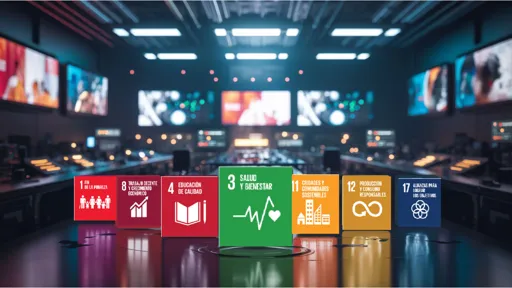
Carmen Pérez Cernuda, Deputy Director of Innovation and Technological Strategy, RTVE
RTVE has implemented an innovative project that utilizes artificial intelligence (AI) and natural language processing (NLP) to analyse and quantify the airtime dedicated to each of the United Nations Sustainable Development Goals (SDGs, see below) and their specific targets in the content broadcast on its channels. Additionally, RTVE makes this information available to the public through an open-access website, thus reinforcing its commitment to transparency and the United Nations’ 2030 Agenda.
Technical challenge
The automatic classification of audiovisual and radio content based on the SDGs is a technically complex challenge, as they encompass a wide range of topics. This required the development of robust, flexible, and constantly evolving ontologies – formal descriptions of knowledge as a set of concepts within a domain and the relationships that hold between them – capable of capturing
the diversity of expressions and synonyms.
We determined from the start that the analysis should rely on the subtitles of the programmes, accessible via an API – application programming interface – on the RTVE website. This would demand highly sophisticated semantic analysis tools capable of understanding context and interpreting content.
The project was approached in two phases: the first involved applied research with the Universidad Carlos III (Madrid) and RTVE’s in-house team leveraging its expertise in NLP. The second phase was conducted through a public tender, with a proposal from the Salvador Soler-Mundo Justo Foundation (PW-FSS) winning due to its solid solution for both analysis and visualization.
A key to the success of this project was the early establishment of a multidisciplinary working group composed of engineers and experts from RTVE’s corporate social responsibility directorate. Once the project was awarded, representatives from the PW-FSS joined the group, holding regular meetings to enrich the project with diverse perspectives.
Another fundamental aspect was the creation of a quality control procedure based on weekly reviews of a sample of the system’s results. Cases where human reviewers disagreed with automatic classifications were discussed by the entire team to enhance and update the folksonomies (user-generated ontologies). Additionally, a panel of experts from various disciplines was consulted when needed.
Data visualization
Once content is classified, clear and accessible visualization of the results becomes essential. For this purpose, an interactive web platform was developed, open to the public, allowing users to intuitively explore the data.
Using filters and searches, users can generate visual representations of SDG coverage over time, by programme, channel, or topic. If interested, users can access the analysed television show on the RTVE website with a single click.
Publishing this data improves RTVE’s transparency by providing detailed information to audiences and regulatory bodies, fostering greater public awareness of the SDGs, and reinforcing RTVE’s role as a leader in promoting sustainability.
This project marks a significant milestone in the use of technology to measure the social impact of media. By quantifying the coverage of the SDGs and their targets, RTVE not only fulfils its commitment to the 2030 Agenda but also sets a new standard for the audiovisual industry.
This article first appeared in the March 2025 issue of tech-i magazine.
